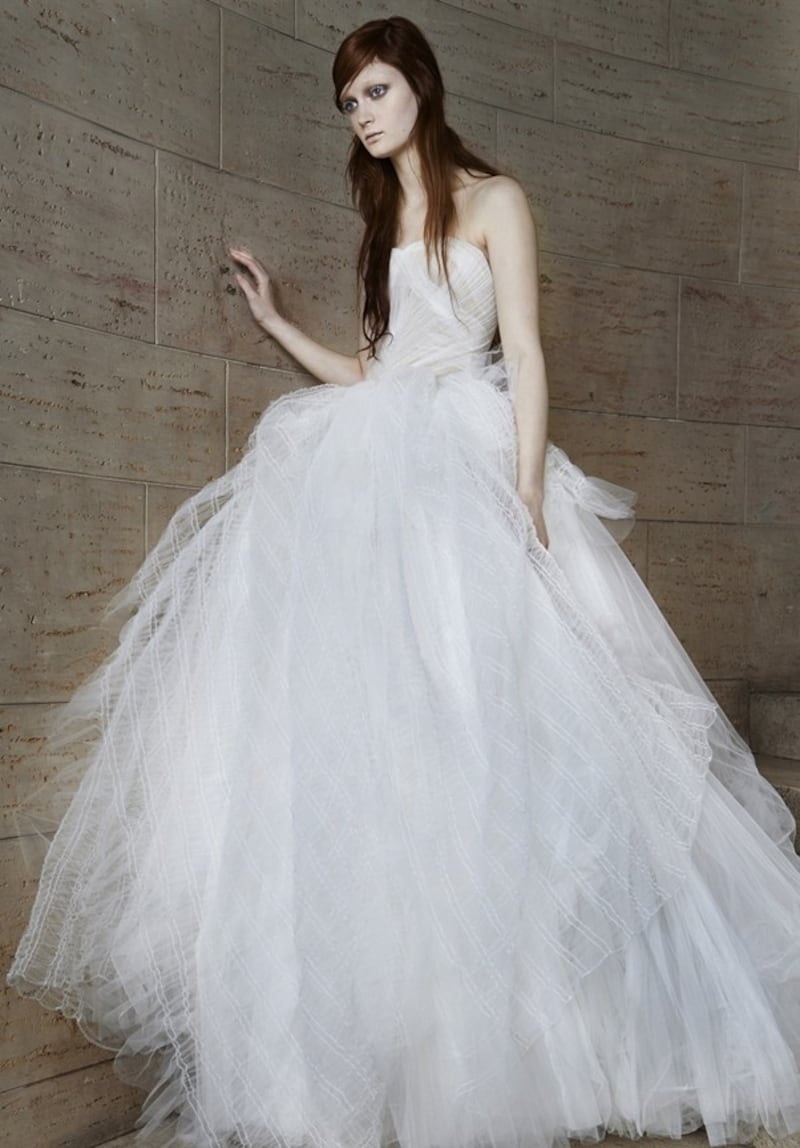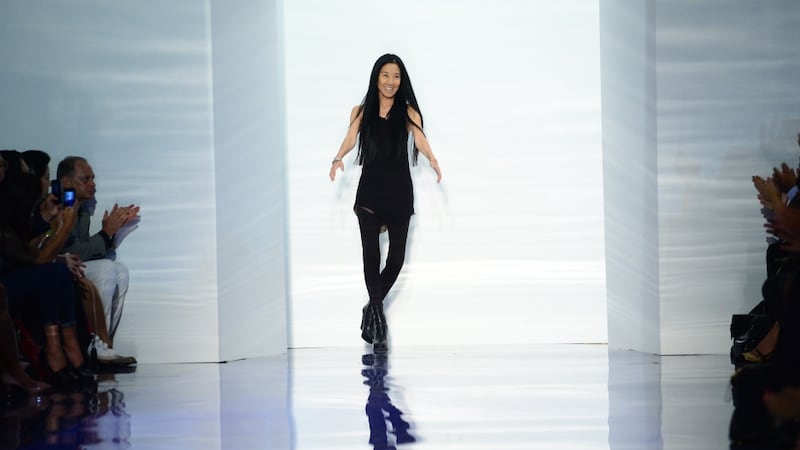
“It’s very important to me that these not be viewed just as wedding gowns,” said Vera Wang, the pre-eminent wedding-gown designer for a generation. She was on the phone discussing her decision not to hold a live show during the recent presentations of bridal collections in New York, a kinder, gentler and briefer version of Fashion Week, with profusions of curling-ironed hair, platform pumps and champagne flutes twinkling in broad daylight.
Instead, Wang’s public relations department had circulated a short online = video titled “Chasing Alix,” after the self-effacing early 20th-century French couturier Madame Gres (aka Alix Barton). The video showed models in dresses whose cobwebbed bodices and fraying edges, accessorized with black rose petals and the odd tattoo, suggested not heterosexually coupled bliss but a small sorority of blase Miss Havishams.

Wang opened her bridal studio in 1990 and 22 years later separated amicably, as “conscious uncoupling” used to be called, from her husband, Arthur Becker. This is not the first time she has put forth an unconventional vision of that great American mass theater production, the wedding.
“I’ve been subversive in measured amounts,” she said, referring to times when her signature dresses were black (fall 2012), or red, as in China (spring 2013), or “architectural” (spring 2014). But perhaps never before, in fashion or history, has a man seemed such an optional part of the overall edifice.
“I don’t want to use the word goth, but certainly there was a sisterhood,” the designer said of the video, in which several female models stare into the foggy distance, entwine hands and twirl wanly, Lorde-like, in an abandoned manse. She intended to evoke not Dickens, but the Brontes. “I didn’t think we had to be literal with a groom and a tuxedo and all that.”
Yeah, who needs a groom, anyway? With marriage rates low and the contours of the institution inexorably shifting to accommodate same-sex and transgender couples, surely Wang would not be the only one in the wedding-dress business to be lifting the veil, or dispensing with it entirely.
But visits to a half-dozen bridal presentations showed only pockets of innovation here and there. Such as Zac Posen, who put actual pockets on a soutache-embellished skirt with a fitted bodice, which could come in handy for stashing the nuptial cash gifts standard in many cultures (or the money saved by spending only $245 on the ensemble; many sell for 10 times that much and up).
“I get in there with my scissors,” Posen said fiercely, standing in his atelier for an old-fashioned appointment-only viewing, redolent of the “gentleman seems to know what he wants” scene in Hitchcock’s “Vertigo” (also, fresh lilacs). He was describing not a turn toward deconstruction but his emphatic personal involvement in a mass-produced line, Truly Zac Posen, that has been ordered for a second season by the chain David’s Bridal and runs, with unusual generosity for a name-brand designer, from size 0 to 26.
“I’ve always been about embracing women and their bodies,” said Posen, whose most recent public-relations splash was dressing his former baby-sitting charge, Lena Dunham, in canary yellow for the Golden Globes. Press notes highlighted the designer’s “red-carpet heritage,” as if the procession toward the awards ceremony and that toward the altar are all part of one continuum of self-display.
Certainly now that cameras are rolling at all times and from all angles at both occasions, details in the back (bows suggesting a bride is delightful package to unwrap, a long line of small buttons, or intricate embroidery) have become as important as those in the front, and Posen offers plenty. “Give them something to look at,” he said, “so it can be the ‘Hello, then goodbye.’” At which point the mental camera panned over to Katharine Ross’ Elaine bolting from a modernist church (“ Bennnnn!”) in “The Graduate.”
And if Posen has his way, the Elaines of this millennium will be as fleet of foot as the mythical Greek huntress Atalanta of “Free to Be ... You and Me.” “Every one I test for the wobble factor,” he said, flicking his index finger at the tops of a row of high-heeled shoes created to complement Truly dresses, priced at $85 to $145 a pair. “We were thinking of doing a flat - the market said no. But we’re developing a wedding wedge.”
At Reem Acra, toes were bared in beachy sandals. But the real action was above the waist, with several necklines plunging to the solar plexus in the silhouette revived by “American Hustle” and reviled by prospective mothers-in-law the world over.
Even the more demurely dressed models wore their hair long and loose. Their faces were flushed; their lips reddened; their expressions confident and knowing. Before and after the show, three male performers in fedoras pantomimed lap dances as if at a bachelorette party. Acra, whose work has been worn by Madonna (whose early career she alluded to with lace gloves), gamely gyrated, too, as she took her bow in sequined high-top sneakers.
Well known in his heyday as a Hollywood costume designer, couturier to Jackie Kennedy and brother of Igor Cassini, the second incarnation of the gossip columnist Cholly Knickerbocker, Oleg died in 2006. The house of Cassini has since fallen somewhat off the map, except in this rarefied realm, where it is also a marquee name at David’s Bridal, at least at the Houston branch.
“Oh, my God,” was the verdict of an employee from there as a series of meringue-like frocks with sweetheart necklines emerged onto the runway. Popping a stick of gum into her mouth, she periscoped up a rhinestone-encrusted iPhone to record the golden moment.
The billowing skirts, post-deb affect and Frank Sinatra soundtrack recalled the first wedding of Cassini’s most famous client more than 60 years ago (though that gown was designed by the largely forgotten African-American designer Ann Lowe), as well as those of more recent political brides, like Chelsea Clinton. As the success of “Frozen” proves, the princess paradigm persists even in progressive quarters.
Certainly this was true at the crowded Carolina Herrera and Oscar de la Renta shows, both in Midtown, both displaying plenty of tulle and organza for the jet set. Regardless of whether de la Renta, in his 80s, is shopping for a new creative director, his bridal unit confidently distills the essence of his brand: judicious ruffle here, trumpet hem there. One dress came, refreshingly, in cotton (what bride doesn’t fantasize about throwing her dress in the “gentle” cycle?), though it was upstaged by a few very young flower girls walking the runway in light makeup, not all of them smiling.
There were coos and fond chuckles, but also some faint “tsks” as scores of electronic shutters clicked and index fingers poised to post. Instagrambivalence? The eyelet bikini and pareo that followed, though, were an unambiguous knockout. (What bride doesn’t fantasize as well about running into the surf after her vows, if not out of the church?) And with temperatures outside inching toward 80 degrees, even a Coney Island beach suddenly seemed feasible. The Hudson River flowed temptingly out the window of the dramatic 14th-floor loft setting - talk about vertigo - for Marchesa, the brand codesigned by Harvey Weinstein’s wife, Georgina Chapman.
“Wow,” Weinstein said, surveying a standing-room-only crowd. With their artfully wispy hair and intense gazes, some of the models wore a faint sheen of sweat. And though there were a couple of cocktail lengths and cute Chantilly lace socks, one dress powerfully summoned that worn by Kennedy’s contemporary (and Cassini’s onetime paramour) Grace Kelly, albeit with - again - pockets.
Monique Lhuillier also got cute with the feet, showing an open-toed lace bootee or two at the large, open Cedar Lake Contemporary Ballet space nearby. Models wore shades that included “blush, hydrangea, pistachio and mist,” as if springing from a box of the ubiquitous Ladur?e macaroons. They fanned out over the Olympic-size floor, then made their way to a stage where there were a few empty chairs. A tableau that had seemed Samuel Beckett slowly morphed into John Singer Sargent.
Afterward, a couple of the models, denuded of finery that had included a skirt with giant rosettes and yards of the aptly named “illusion” fabric, stood on Ninth Avenue in tough black jeans and jackets, smoking and chatting as they tried to hail a cab. No longer goddesses, they were just a couple of millennials, the obvious intended audience for “Chasing Alix.”
“A lot of them are getting engaged, but they don’t necessarily want tradition,” Wang had said of this up-and-coming demographic. She described a goddaughter getting married this year who is considering something “very avant-garde and shredded.”
“She’s blond and 5-10 and 25,” Wang said. “I said ‘God, whatever you want.’ She just looked so rockin’.”














